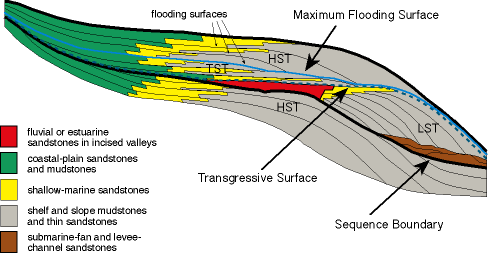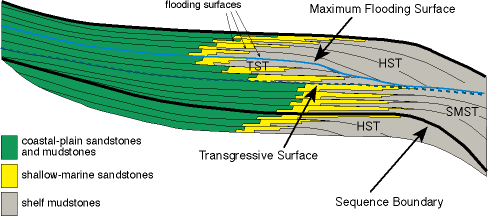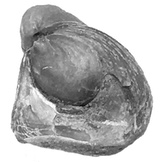Type 1 and Type 2 Sequences
In the older sequence stratigraphic literature (especially in the 1980s and 1990s), there was considerable discussion of type 1 and type 2 sequences, concepts that have largely since been abandoned or ignored. This is unfortunate, because understanding the differences between these also helps understanding the relationship between parasequences and sequences. Type 1 and 2 sequences differ in what happens at the shoreline during a eustatic fall in sea level.
In a type 1 sequence, there is a relative fall in sea level at the shoreline because the eustatic fall in sea level is faster than the rate of subsidence at the shoreline. As a result, rivers typically will incise, and a surface of forced regression will form on a wave-dominated shelf. In short, the shoreline experiences a fall in sea level in a type 1 sequence. All of the discussions so far in this online guide have been about type 1 sequences.

A type 1 sequence developed on a shelf margin, adapted from Van Wagoner et al. (1990). Note that no falling-stage systems tract is indicated, in part because Van Wagoner did not recognize this as a separate systems tract (he included it in the HST), and in part because they are thin and often destroyed by subsequent erosion at the subaerial unconformity.
In a type 2 sequence, the rate of eustatic fall is not greater than the rate of subsidence at the shoreline, and as a result, the shoreline continues to experience a relative rise in sea level. Because of this, progradational parasequence stacking continues, although it may be accelerated owing to lower rates of accommodation. Similarly, rivers do not incise at the shore, and a surface of forced regression does not form seaward of the upper shoreface. In short, the shoreline does not experience a fall in sea level in a type 2 sequence.

A type 2 sequence developed on a shelf margin, adapted from Van Wagoner et al. (1990)
The architecture of a type 2 sequence differs from a type 1 in several ways. First, it will lack incised valleys. Second because there is no relative fall at the shoreline, no surface of forced regression will develop, and therefore, a type 2 sequence will lack a falling-stage systems tract. Third, no lowstand systems tract will be present, and the equivalent strata are called the shelf-margin systems tract (SMST). Because most workers no longer recognize the concept of a type 2 sequence, it is uncommon to encounter the SMST term in the more recent sequence stratigraphic literature.
An unconformity may develop in a type 2 sequence, but it will be limited to coastal plain strata, which may display truncation and onlap (see the left third of the figure above). The correlative conformity to this surface extends seaward on the cross-section, although it is important to underscore that this surface has no physical expression and cannot be identified in outcrop. Where this correlative conformity meets the coast, the strata below and above are characterized by progradational to aggradational stacking. Identifying this correlative conformity is effectively impossible with outcrop data, although it can be located on seismic.
This inability to identify a subaerial unconformity in a type 2 sequence illustrates the relationship of parasequences to sequences. In the figure of the type 2 sequence above, imagine that the higher-order cyclicity (that producing the parasequences) was absent. Through the HST and SMST, there would be net progradation, followed by a major flooding surface (top of the SMST), an interval of retrogradation (TST), and the next interval of net progradation (the next HST, plus the next SMST, not drawn). This pattern of major flooding surfaces separating intervals that are largely progradational is what parasequences are. Detailed descriptions of parasequences often report a thin deepening-upward interval at their base, equivalent to the TST. In short, parasequences are what we recognize when we cannot identify subaerial unconformities and their correlative surfaces. When we cannot identify those surfaces, we package those strata not on those unconformities, but on the major flooding surfaces that we can identify.

